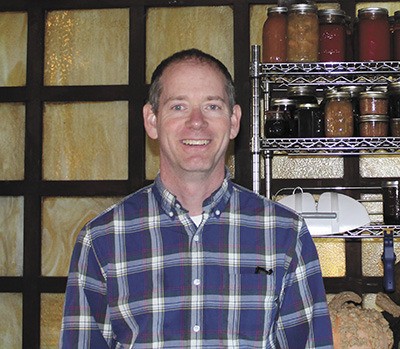Islander Kurt Timmermeister’s name is in the news a lot these days. Google him and links to national media pop up — the New York Times, Boston Globe, Washington Post, Seattle Times, PNW Magazine and Bloomberg Radio. His new book, “Growing a Feast,” published by W.W. Norton, hit bookstores Jan. 1, and considerable buzz is building about this local tale of “one meal two years in the making.”
Push aside the hype and what you find behind the former restaurateur and chef, now farmer, cheesemaker and writer, is a man whose trajectory in life appears fueled by vast amounts of creative energy and focused hard work, with an aesthetic eye turned toward making his environment “both thoughtful and beautiful.”
Sitting in his farm’s cookhouse — a French timber-frame and packed concrete building — at a long fir table built to seat 20 with jars of green pickles, red peppers, jams and jellies stacked behind him, Timmermeister offered a simple insight into the multiple successes he’s launched from Kurtwood Farms.
“I’m not afraid of change or risk,” he said “I like new challenges and find failure fascinating.”
Timmermeister can reel off a list of start-up projects — beekeeping, vegetable farming, sheep tending, among others — he later stopped, but not a hint of failure emanates from the 13 storybook acres of rolling green pastures that make up Kurtwood Farms today, only the earthy tang of ripening cheese from his three popular farmstead cheeses — Dinah’s, Flora’s and Loghouse.
Timmermeister lives down a nondescript potholed driveway that belies the farm’s tidy pastures, split-rail fences, outbuildings and the oldest standing restored log house on Vashon. Think dairy farmstead from the Channel Islands, birthplace of the Jersey cows grazing Timmermeister’s land, perhaps Vermont pastureland, even a French farm with outbuildings, or as Timmermeister cheerfully recounted, one writer labeled Kurtwood Farms “more Donald Judd than funky farmer.”
Of course the farm didn’t start out picture perfect. In Timmermeister’s first book, “Growing a Farmer,” he described buying four acres in 1991 of overgrown blackberries with a smelly chicken coop and decrepit log house from the 1880s. Turning the mess into a farm became a full-time task for the man who likes a challenge.
“I started with growing veggies,” he recalled. “Figuring it all out was thrilling.”
Looking around, it’s obvious Timmermeister maneuvers well within the creative process. He likes to make things.
“At the end of the day, I’ve made a product. I’m not a consultant stuck in an office. I love that.”
He also knows how to manifest his visions. Take his famed farm-to-table Sunday dinners inspired by a Portland supper club and celebrated by foodies in Seattle and beyond.
“We made everything except the sugar, salt, pepper and coffee. We raised it and grew it, all the meats, veggies, fruits and herbs. I wanted to show the literal connection behind the food we eat,” he said.
The suppers ended three years ago when Timmermeister went deep into making his artisan cheeses, building a 300-foot long subterranean cheese cave, where the rich butterfat from Timmermeister’s herd ripens for four months into the semi-hard, tome-style Loghouse cheese.
He likes dropping off big lugs of cheese to restaurants and stores in Seattle, values the whole process from milking the cow to hand-wrapping the rounds, but something went missing when he stopped the dinners — he missed cooking for people. Then the idea to grow a feast for 20 of his friends.
What evolved from the seed of that idea is what “Growing a Feast” is all about. Timmermeister said the first eight chapters descibe everything that went into making the dinner, while the last three chapters recount the dinner and the morning after.
“It started with the birth of a calf born two years (before the meal) and includes many Vashon folks,” he said.
Contributing to the dinner were islanders like Michiko Uto, who showed Timmermeister where to pick chanterelle mushrooms in Island Center Forest. Sandy Mattara at the Burton Store with her meat lockers played a major role as did Leda Langley from Dockton with her vegetable starts, among others.
This is a story, concluded Timmermeister, about people and food, where our food comes from, the processes behind it and the people who share in the knowledge and enjoyment of it. It is the chronicle of a singular farm-to-table meal grown, gathered and cooked at a particular place on a certain island in Puget Sound, written by a man who turns milk into cheese, experiences into books, a decrepit log home into a spare elegant structure and homegrown food into a feast for 20 friends, two years in the making.
Vashon writer Kurt Timmermeister will sign and read from his new book, “Growing a Feast,” at 6 p.m. Friday at the Vashon Bookshop. Copies of “Growing a Feast” and “Growing a Farmer” will be available at the bookshop.


